Two OMAP 3430 Phones: Nokia N900 and Motorola Droid
by Brian Klug on June 10, 2010 9:29 PM EST- Posted in
- Smartphones
- N900
- Maemo
- Motorola Droid
- Droid
- MeeGo
- Android
- Mobile
Screen - Display
Both the N900 and Motorola Droid use traditional LCD displays. Of course, the interesting comparison points are the HTC Incredible and Nexus One displays, which use AMOLED. Though they advertise the same resolution, they do so using a proprietary RGBG grid marketed under the trade name 'PenTile' while the traditional LCDs use an RGB bayer grid pattern.
It remains an interesting point of contention whether the PenTile pattern offers superior spatial resolution than the traditional bayer grid pattern. Ultimately one needs to take into account the human eye system and subsequent response to really make a definitive answer. The AMOLED display is incredibly contrasty, so much so that I measured the black level as 0. That's right, 0 - meaning our contrast is effectively infinity. In fact, that makes sense - AMOLED subpixels are turned off when displaying black by nature of how they work. However, the white point I measured seems too low - interestingly, this is probably a result of the unique subpixel arrangement.
Personally, I can notice the difference in dithering and can discern the unique subpixel arrangement, but I know what to look for. For me, not being able to see the pattern or an offset screen door effect makes the Motorola Droid or N900 displays the better choice.
But if contrast and brightness are what matter, the AMOLED blows the competition away.
Side by side, the Motorola Droid and AMOLED display on the Incredible seemed just as bright, with the Incredible just edging out the Motorola Droid. Having played with two AMOLED displays, it appears like the displays are very oversaturated - perhaps at the expense of being accurate. Take a look at the yellows and oranges in the AnandTech webpage - it's easy to see that they're more saturated. I'm still trying to come up with a foolproof way to measure color accuracy, however.
The N900 isn't quite as bright or contrasty as either of the two phones. It's entirely possible that this is due to the resistive screen versus the two capacitive digitzers. Note that I'm positive the AMOLED display on the Incredible is causing some sort of measurement error to occur on my i1D2 colorimeter, as it definitely appears substantially brighter than the Motorola Droid. It's highly likely that the measurement is being skewed because of the unique PenTile arangement, or something inherent in the AMOLED display technology.
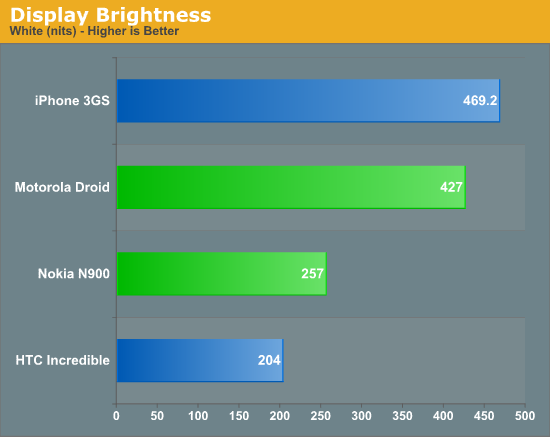

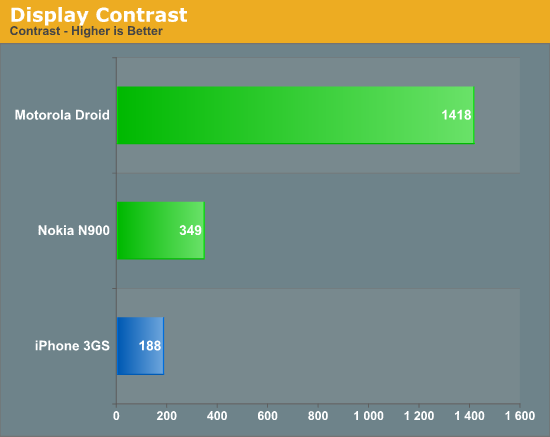
The HTC Droid Incredible is notably absent from the display contrast graph because contrast is... well... infinite in this circumstance. Or at least indeterminate. Whatever the case, AMOLED delivers the absolute best contrast possible. It's really amazing in person.
Outdoors, however, the N900 is an obvious winner - just look at the direct sunlight example down below. The AMOLED display on the Incredible is more difficult to read in indirect sunlight, and very challenging to look at in direct sunlight.
One last thing I'd like to note is that I've read in more than a few articles some claims that the AMOLED display is readable with polarized glasses - that there aren't any angles where there is complete extinction like with normal LCDs. This is false; rotate any AMOLED screen around, and brightness will still fall off following cosine squared like any other analyzing polarizer.


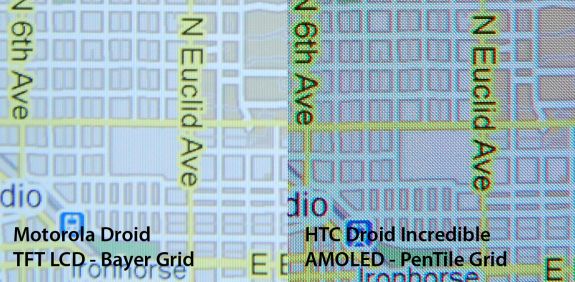
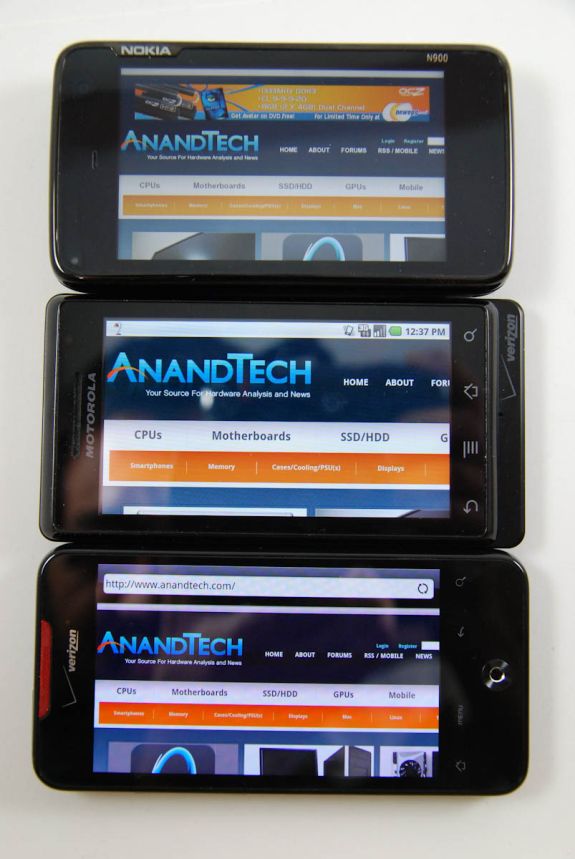
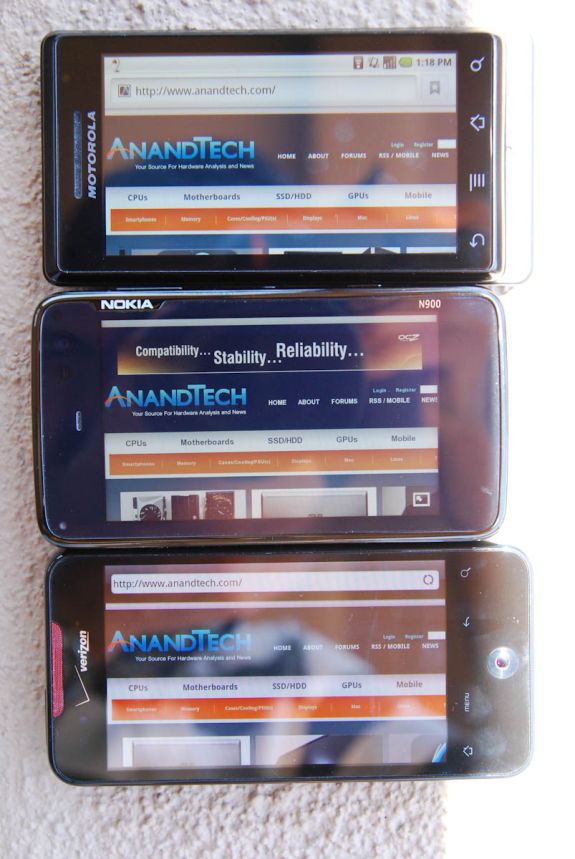
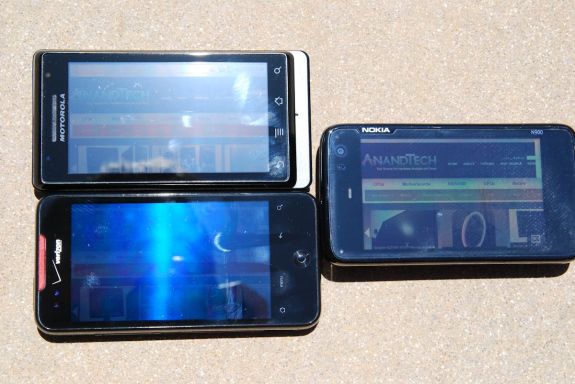








68 Comments
View All Comments
Fri13 - Sunday, June 20, 2010 - link
Symbian is server-client architectured operating system. Symbian has EKA2 microkernel + servers (modules). But Symbian is not at same time _just_ the operating system. It has other features (like libraries and so on) as well what does not belong to the actual OS.Fact is that Symbian really is open source.
But in other hand, the Android is not the operating system. It is a software system. The Linux is the operating system in the Android. Linux is monolithic kernel. Monolithic kernel is exactly same thing as operating system. It is the oldest (actually original) OS architecture. Server-client and layered architectures were developed almost few decades after the monolithic because there was demand to get OS architecture what is in theory more secure and more stable, but slower.
Symbian is licensed under EPL. While Linux OS is licensed under GPLv2 (only).
Both licenses are aproofed by the OSI and FSF. So both OS's are Libre software.
Android is software system what has multple different licensed software in it. The Linux OS in it is the GPLv2 (what can not be changed) and the distributor itself can use as well closed source software if the license allows. Usually this means that the software platforms or the softwares what are responsible for user interface can be with different license than F/OSS license.
By the facts, it is not true at all to say that "Android is not F/OSS operating system". Because a) Linux kernel is the operating system in Android. Android is just one distribution of the Linux. b) When talking about the operating systems and android, if wanted to be very wide speaking by terms, then Android is totally F/OSS.
numberoneoppa - Thursday, June 10, 2010 - link
Great article, Brian. I learned a lot. =)legoman666 - Thursday, June 10, 2010 - link
I love my N900 :D I bought it last November, right when it was first released. I had a N810 at the time, so I was excited to get the next iteration. With PR1.2 and a modest overclock to 800mhz, it scores ~12000ms on the sunspider javascript benchmark, which is on par with the HTC Incredible and the Nexus 1.I didn't have to get t-mobile, as my local carrier, Cincinnati Bell, uses the same 3g frequencies as T-mobile. I get blazing fast speeds of 3mb/s.
As Brian said in the review, the Skype integration is excellent. It even tells you how much credit you have remaining and the call cost at the end of the call. (And I can make video calls over 3g, take that iPhone)
topsecret - Thursday, June 10, 2010 - link
You should test the N900 with it running meego.Talcite - Friday, June 11, 2010 - link
Nokia doesn't plan to port meego to the N900.CityBlue - Friday, June 11, 2010 - link
Yes they do plan to port MeeGo to the N900 - in fact, the N900 is the primary development platform for MeeGo so not making it available in one form or another would be utterly ridiculous.What Nokia have said is that the version of MeeGo that will be made available for the N900 will not be officially supported, which basically means you can't go running to Nokia Care when you find a bug. Since I can't believe anyone does this even with a supported OS, the lack of Nokia Care is no great loss - you'll still have a very large and committed community to fall back on for help.
So in brief: Yes, MeeGo *IS* coming to the N900 - whether you install it or not is your choice.
jed22281 - Friday, June 11, 2010 - link
Yup, exactly what cityblue said.Brian needs to clarify this in his article.
There'll be plenty of "unofficial" support for meego on n900
tbutler - Wednesday, June 23, 2010 - link
...sorry, those airquotes have some very painful memories for those of us who lived through the 770 era. When 'unofficial' support meant a kludged-together hack.Brian Klug - Friday, June 11, 2010 - link
Thanks for the clarification CityBlue, I'll definitely update. I wrote some of this partially when support wasn't fully understood.-Brian
topsecret - Friday, June 11, 2010 - link
"the Motorola Droid remains the flagship of Android phones that come with a hardware keyboard"I dunno, the samsung moment is a pretty nice phone.